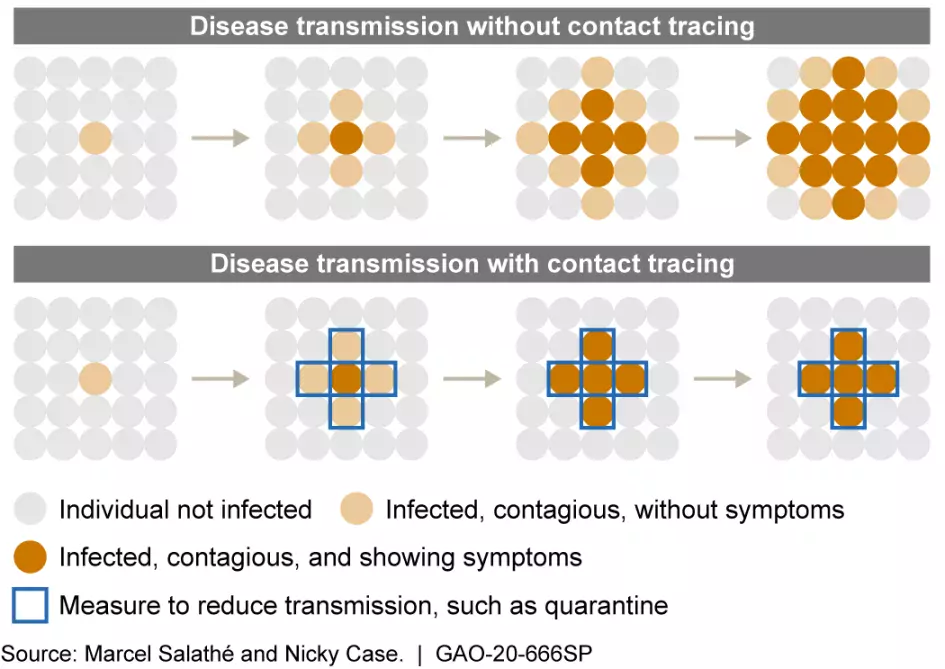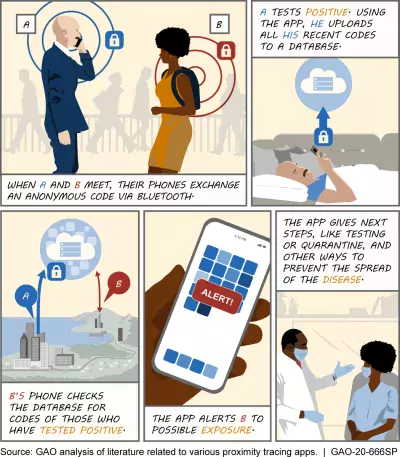The Tech Behind COVID-19 Contact Tracing
Public health officials are working to contain the spread of COVID-19, in part by using contact tracing applications to help reduce transmission rates.
Contact tracing identifies infected individuals and notifies their “contacts”—i.e., all the people to whom they may have transmitted the disease. Infected individuals and their contacts are then asked to quarantine, get tested, and take other steps to reduce the spread of the disease.
Listen to our podcast with Karen Howard, a Director in GAO’s Science, Technology Assessment and analytics team, and read on in today’s WatchBlog for a closer look at our recent Spotlight on contact tracing apps and the opportunities and challenges they present.
Contact tracing apps
Contact tracing apps use digital technology (like smartphones) to track the spread of infectious diseases. These apps detect contacts using either Bluetooth, GPS, or a combination of the two.
Bluetooth is the most common wireless technology used for contact tracing, and relies on anonymous codes shared between phones. These codes contain no information about location or user identity, which helps safeguard privacy. When a user downloads the app and comes into contact with a person who has (or later reports) an infection, the user would receive a notification such as the following: “You have recently been exposed to someone who has tested positive for COVID-19.”
Opportunities
Traditional contact tracing methods require hundreds of thousands of trained contact tracers to identify individuals who could be exposed to a disease, contact them, and then see who they might also have exposed.
Contact tracing apps can greatly expedite and automate this process. These apps could also slow the spread of disease more effectively because they can identify and notify contacts as soon as a user reports they are infected. And, unlike traditional contact tracing, these apps do not require users to remember or be acquainted with the people they have recently encountered.
Challenges
One major issue with this technology, however, is that some contacts are not detected or are falsely identified. For instance, Bluetooth apps may ignore barriers preventing exposure, such as walls or protective equipment, and incorrectly notify an individual of a contact even though they were not exposed to the virus. Likewise, apps may overlook exposure if 2 people were not in proximity long enough for it to register as a contact.
Low adoption rates pose another challenge. For example, some states in the U.S. may choose not to use contact tracing apps. The public may also hesitate to download these apps over data privacy concerns.
Additionally, contact tracing apps require regular access to smartphones and knowledge about how to install and use apps—which may be difficult for some vulnerable populations, including seniors.
For more about how to effectively incorporate contact tracing apps into the COVID-19 response, check out our recent Spotlight.
Comments on GAO’s WatchBlog? Contact blog@gao.gov.
GAO Contacts
Related Products

GAO's mission is to provide Congress with fact-based, nonpartisan information that can help improve federal government performance and ensure accountability for the benefit of the American people. GAO launched its WatchBlog in January, 2014, as part of its continuing effort to reach its audiences—Congress and the American people—where they are currently looking for information.
The blog format allows GAO to provide a little more context about its work than it can offer on its other social media platforms. Posts will tie GAO work to current events and the news; show how GAO’s work is affecting agencies or legislation; highlight reports, testimonies, and issue areas where GAO does work; and provide information about GAO itself, among other things.
Please send any feedback on GAO's WatchBlog to blog@gao.gov.






